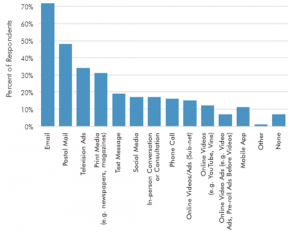Looking for a Fast Way to Boost Your Bottom Line? Say “NO” to More Spreadsheets.
A single spreadsheet error cost Fidelity $ 2.6 billion.
How?
An employee forgot to add a minus sign, indicating a loss of $ 1.3 billion. Instead, the value went in as a profit and the company paid out shareholders.
In fact, spreadsheets are so bad for businesses that there’s an actual group of experts who meet every year and discuss the issues and risks they pose for organizations.
While some spreadsheet use is okay. The fact is that most growing businesses over-rely on them. And if you’re not careful with how your business uses platforms like Excel, you could end up ruining your business.
Still need convincing? Sadly, there are plenty of reasons that clearly illustrate just how bad spreadsheets are for collecting, reviewing, and using data in your business.
11 Reasons Why Spreadsheets Are Bad For Business

1. Spreadsheets Are Prone to Human Error
As already mentioned, spreadsheets open the door to human error. With all the cells, rows, and columns, data can be hard to track and manage.
Add complex formulas into the mix, and you’ve got the perfect storm for data entry errors to occur. More variables mean it’s more likely for people to put information into the wrong field, resulting in massive errors.
If you run a small business, you may be able to recover from some mistakes and losses. But what happens as your business expands? Using more spreadsheets to fill the gaps will only damage your chances of continued success.
These mistakes may not all end up in the headlines. But when they do, they damage a company, its employees, and its future prospects.
2. Fixing Problems in Spreadsheets Is Challenging
There’s no update you can install to remove human error from manual entry. Even if you could properly train everyone while adding more people onto teams (to lighten each team member’s workload) for data entry, there’s still a chance for error.
Additionally, fixing problems with spreadsheets often comes too late. That’s because spreadsheets work in data silos. And there’s no way to connect them directly to the various platforms existing throughout an organization.
Instead, you have to manually look over data, then copy and paste it into the appropriate places in the specific spreadsheet. And this poses a problem as well.
How do you know if the data is in the right field or not? If you didn’t write the formula, it’s very hard to audit spreadsheets. As a result, you have to ask the person who created it to look it over. But if you’ve ever edited your own work, you know how problematic that can be…

3. Collaboration in Spreadsheets Is (Nearly) Impossible
The very nature of spreadsheets makes collaboration tricky. If your organization uses Google Sheets, then you can collaborate somewhat. (Excel? Forget about it.) As a result, employees end up sharing spreadsheets over email. And there’s a lot of back and forth as they try to get work done.
Still, that process can still lead to data entry errors, deleted values, and duplicate entries. Plus, UX isn’t great for collaborating either. And new data has to be regularly imported. Manually. This means you could be working data in an outdated spreadsheet without knowing it.
4. Spreadsheets Damage Transparency
Most spreadsheets compile data from generated reports. This means departments have to run and submit these reports regularly. After that, someone has to compile the information.
That’s a time-consuming process.
Plus, it also prevents real-time reporting. For example, if your IT department needs a week or two to run and compile the reports, then your data points could already invalid by the time you discuss them.
How can you make key-business decisions in real-time when so much time has passed since the original data pull?

5. Spreadsheets Provide Too Much Unusable Data to Sort Through
Spreadsheets are the data version of Hoarders. Companies collect and collect and collect customer data. Afterward, they silo it into spreadsheets where access is difficult.
Finding relevant spreadsheets and inputting the necessary details manually tends to be a hassle. Plus, employees add a different element to the mix. They often cut corners, letting information falls through the cracks.
As a result, you end up with an incomplete picture of your business and your customers. Additionally, some departments will have way more data than what’s necessary (or relevant). And that’s data you’ll have to sort through. Other departments will have fractured, incomplete snapshots.
Either way, it’s a jumbled mess. And more work for you.
6. Spreadsheets Are NOT a One-Size-Fits-All Tool
The main function of spreadsheets is to capture data. Their advanced functions empower users to compile data streams and output results. But, they’re not made for business monitoring, auditing, detailed reports, or any kind of high-level business process management.
Using them like such is kind of like using a hammer to fix everything. It’ll work great on nails, but you start running into problems the more complex the task becomes.

7. Data Is Hard to Find in Spreadsheets
Employees waste a lot of time each day simply looking for information. And it’s hard to blame them.
With data spread out all over various reports, scattered across files and hard drives, it’s a wonder anyone can find the information they need. Data is only valuable as long as you can access it and leverage it to grow your company.
But without a clear way to do that, your organization misses out on the overall picture and misses a clear advantage.
8. Spreadsheets Have a Steep Learning Curve
Most people have a general understanding of what spreadsheets do. But to use it for high-level business tasks, you need to know how to create and use complex formulas. These formulas aren’t easy to learn. And they vary from company to company depending on the task at hand.
That means onboarding new employees and training them on spreadsheets for your business will take additional time and run up additional costs. Keep in mind that there’s also a high risk of turnover if you have too many inefficient processes…

9. Spreadsheets Are Insecure (And Unnecessarily Risky)
Spreadsheets aren’t usually password protected. And if they are, the passwords typically aren’t that effective. (They can be pretty easily cracked).
Additionally, spreadsheets (and their passwords) get shared haphazardly in most organizations. One simple mistake in an email address can send your data spiraling out of your organization.
It’s also difficult to see who edits spreadsheets, making it hard to hold people accountable for mistakes. Without accountability, fraud can run rampant.
10. Spreadsheets Have Horrible UX
Let’s be real here: no one likes looking at spreadsheets. They provide a generic, bland version of the data. And while looks aren’t everything, the interface matters if you want to remember the information.
That’s because you’re more likely to pay attention to the data if it’s in a form you can understand.
11. More Expensive Than Other (Better) Solutions
Yes. You can purchase Microsoft Office for your office at a relatively low cost. And yes, you can access Google Sheets for basically free. But even if MS Office was free, it would still be more costly than other automated solutions.
Even if your employees entered every single piece of data into these sheets and never once made a mistake, spreadsheets would still be more expensive than other solutions.
Why?
Because you have to factor in the labor. Once you start adding up all the time your employees spend looking for spreadsheets, hunting down information, transferring data, fixing mistakes, and even just learning how to use the software effectively, [the costs explode].
In short, you’ll pay far more on labor for clinging to the past and over-relying on spreadsheets in your organization.
And once you account for the numerous errors, costs will only continue to climb.
What’s a Better Alternative to Spreadsheets?
Businesses use spreadsheets to fill in the gaps because they don’t have the applications and processes in place to move data between systems. The easiest solution, it seems, would be to simply build those systems.
Easier said than done, though. Right?
The reason why most businesses don’t run out and build new systems is because of how much traditional application development costs. And how long bespoke solutions take. Plus, there’s a lot of risks involved.
You need to map out, design, test, and deploy a new system. And for businesses with small IT budgets, putting a lot of money into a solution that may or may not work isn’t exactly a sound business decision.
But. There is a solution.
Rather than pursue traditional application development, growing businesses can use low code instead.
Low code platforms allow users to quickly drag and drop applications into existence with minimal knowledge of code. This empowers small, growing businesses and enterprise organizations alike to build the custom apps they need. For a fraction of the cost. And in a fraction of the time.
It really is that simple.
Originally published here.
Business & Finance Articles on Business 2 Community
(31)
Report Post







